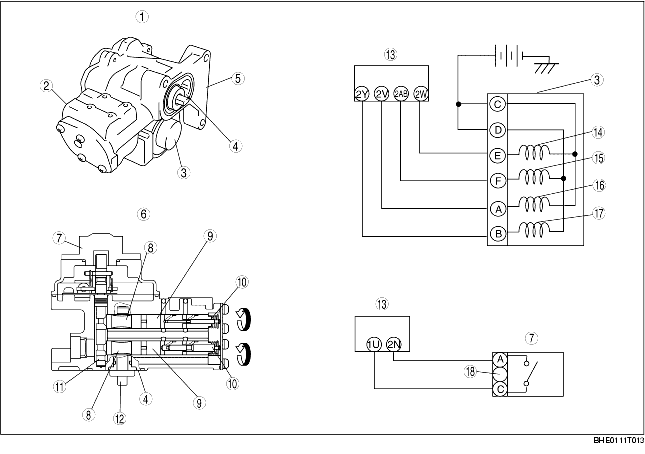
• An electric metering oil pump has been adopted to reduce oil consumption by controlling the amount of oil discharged.
• The electric metering oil pump is controlled by the PCM.
• The PCM sends a pulse signal controlling the amount of oil discharged to the metering oil pump according to the engine rotation, engine coolant temperature, and the amount of intake air.

• Two oil nozzles are adopted on each rotor in order to improve lubrication in the side housing and side seal in accordance with the adoption of the side exhaust system. They are tilted toward the side housing to inject oil directly to the side housing.

• The oil discharging mechanism consists of the plunger and differential plunger driven by the driving worm. The driving worm is driven by the eccentric shaft through the driven gear.
• The amount of oil discharged is controlled by change in the stroke of the plunger and the rotation of the control pin attached to the stepping motor according to the signal from the PCM.
• The operation of the stepping motor is monitored by the positioning switch and it ensures the optimum amount of oil discharge according to the driving condition.
• The oil nozzle receives the barometric pressure from the air hose to prevent the negative pressure from the engine being applied to the oil inlet. Also, a one-way check valve has been adopted to prevent oil from flowing out of the air hose side when the engine is under positive pressure.
• Fail-safe function operates when the engine senses a failure in the stepping motor and the positioning switch.
• When the fail-safe function operates, the PCM keeps the control pin at the minimum stroke position and the oil supply is only in proportion to the engine rotation rate. Thus, the minimum amount of oil at each engine rotation rate is supplied.
• Normal driving is possible when the amount of the oil required by the engine is within the minimum oil discharge.
• When the amount of the oil required by the engine is more than the minimum oil discharge, fuel injection is restricted, increased engine rotation is suppressed, and seizure of each seal inside the engine is prevented.